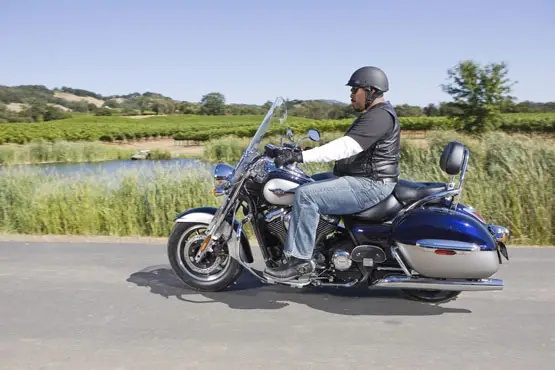
Back to 2011 Kawasaki Motorcycle Index Page
Click photos to enlarge.
They make great desktop images.

2011 Kawasaki Vulcan 1700 Nomad
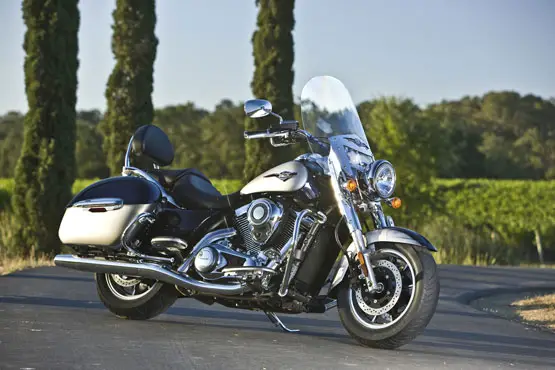
2011 Kawasaki Vulcan 1700 Nomad
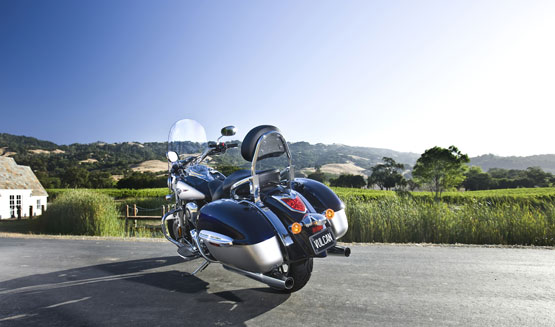
2011 Kawasaki Vulcan 1700 Nomad
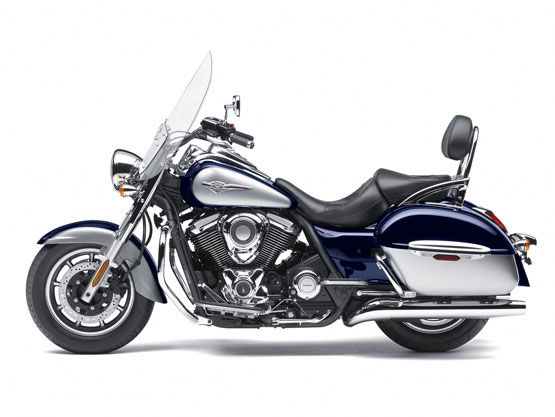
2011 Kawasaki Vulcan 1700 Nomad
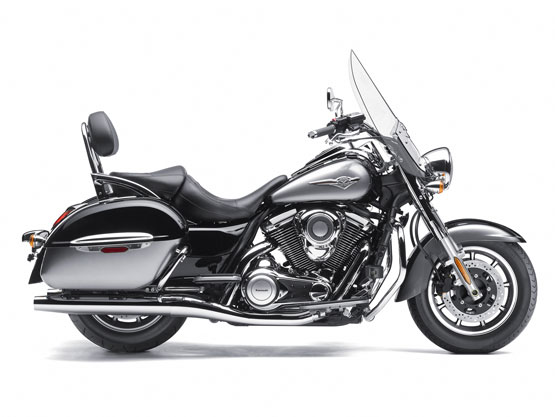
2011 Kawasaki Vulcan 1700 Nomad
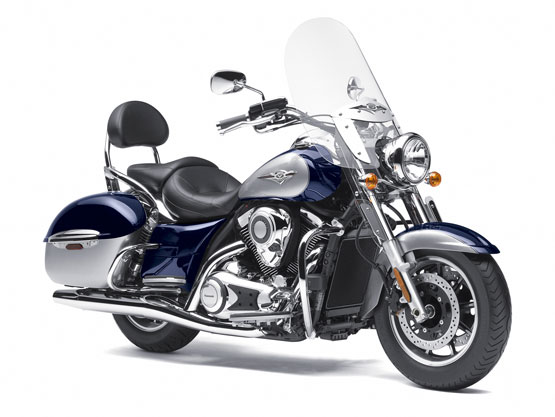
2011 Kawasaki Vulcan 1700 Nomad
– 2011 Kawasaki Vulcan 1700 Nomad
2011 Kawasaki Vulcan 1700 Nomad
Classic, Two-wheeled Americana – With an Urge to Roam
It’s a timeless look, one carved right here in the U.S. during the formative decades of the ’40s, ’50s and ’60s. It’s a look that epitomizes classic American styling, and one that meshed perfectly with the open-road mentality and adventurous spirit then spreading across the country.
Makes sense, then, that Kawasaki’s most adventurous and individualistic motorcycle – the 2011 Vulcan® 1700 Nomad™ – embodies such a look, for it’s a wandering, open-road traveler par excellence, a touring-flavored cruiser that can be many things to a wide variety of riders.
For some it’s a full-blown touring bike, its windshield, hard saddlebags, floorboards, backrest and standard cruise control taking the sting out of long days in the saddle. Strap a sleeping bag to the pillion, jump aboard and let the Nomad’s 1700cc liquid-cooled and fuel-injected V-twin eat up the miles effortlessly while you soak in the sights and decompress.
For others, the Nomad is a more traditional cruiser, a custom-flavored bagger with a look and attitude that tells everyone who’ll listen that it’s as happy cruising downtown as it is running across the county or state – solo or two-up – for the weekend.
The key to the Nomad’s considerable flexibility is its blend of touring-oriented hardware and the uniquely designed Vulcan 1700 platform, which offers a ton of versatility and performance whether in Voyager, Classic or Nomad configuration.
It all starts with that engine, a thoroughly modern interpretation of the big-inch V-twin that’s forged such a hearty reputation over the decades. This 1,700cc powerplant features liquid cooling, a 52-degree V angle, overhead cams, high compression, a long-stroke design and all the latest technology for prodigious power and torque spread over a shockingly wide rpm range. Redesigned mufflers not only enhance the look, but also give it the deep sound you’d expect from a bike like this. There’s not only loads of torque down low—the range you’ll spend most of your time in while aboard—but there is also plenty of grunt all the way to 5,000 rpm. Just twist the throttle and the Nomad generates forward thrust without hesitation, providing ample acceleration for spirited riding and waves of low-rpm torque when you’re just thump-thumping along in top gear, checking out the scenery and relaxing.
More useful technology is found in the Nomad’s fully Electronic Throttle Valve system. Working with the rest of the advanced fuel injection system, the electronic throttle valve enhances engine response without detracting from its distinctive V-twin feel. The system utilizes an Accelerator Position Sensor (APS) and a Throttle Position Sensor (TPS). Both units feed data to the ECU, which adjusts the throttle plates to tailor intake airflow accordingly. The system offers a natural throttle feel, because the APS is activated by a throttle body pulley connected by cables to the throttle grip. Besides the obvious FI advantages such as improved fuel economy and automatic adjustment for altitude changes, the system also permits easy hands-off warm-up and idle speed control. Newly redesigned mufflers that offer a more tapered, classic look necessitated a slight modification to the intake manifold, which promotes even better throttle response. The Nomad also features a water-cooled alternator that produces a staggering 46.8 amps of electrical output – plenty to power a selection of electronic accessories to enrich motorcycle travel.
The Nomad’s electronic cruise control system is conveniently operated from the right handlebar, and can be engaged at any speed between 30 and 85 mph in any of the top four gears. The cruise system can be disengaged in any of the following ways: brake lever, clutch lever, rear brake pedal, or manually turning the throttle grip past the “closed” position. A revised six-speed transmission with quieter and more positive shifting action features overdriven 5th and 6th gears, which contribute greatly to a relaxed ride and excellent fuel economy at highway speeds. Power is routed to the rear wheel via a carbon fiber drive belt that has a 40-percent higher tensile strength than current Kevlar belts.
Color-matched, lockable hard saddlebags set the Nomad apart from its Vulcan 1700 brethren; these top-opening side cases are beautifully integrated and offer bountiful storage: 10 gallons each (38L) as well as front and rear guards to help protect the bike’s engine and saddlebags in case of a tip-over. (Helmet locks are conveniently located on the left- and right-side saddlebag guards.)
Keeping the rider and passenger comfortable on long rides is a top priority, and the Vulcan 1700 Nomad delivers with deluxe seats sculpted to provide additional support for all-day rides. A special backrest with integrated grab bars and floorboards for both the rider and passenger further contribute to the Nomad’s long-distance abilities.
Vulcan designers were able to infuse abundant technology into the 1700 Nomad without sacrificing any of the charm and visual appeal expected from a Kawasaki touring cruiser. Meticulous attention to detail and exquisite craftsmanship of the engine covers, bodywork design and side cases result in a motorcycle that turns heads whether parked in front of a café or cruising down the highway.
Designed to be as light and slim as possible, the Nomad’s single backbone double cradle frame offers a short seat-to-steering head distance, with a correspondingly short wheelbase. That easy-to-reach handlebar facilitates slow-speed maneuvering and helps maximize rider confidence. Adding to the light and easy handling are suspension components that match the Vulcan 1700 Nomad’s intended usage. An elegantly simple rear swingarm with twin air-assisted shocks provides 3.1 inches of rear suspension travel, and features air spring preload and four-way rebound adjustment. Up front, a large 43mm fork offers precise steering feedback and 5.5 inches of travel.
The Nomad rolls on nine-spoke cast wheels fitted with tubeless tires: a 130/90 front and 170/70 rear are mounted. Dual 300mm front disc brakes with twin-piston calipers and a 300mm rear disc brake with a two-piston caliper help bring this stylish machine to sure, powerful stops.
With its combination of traditional styling, sophisticated technology and touring refinement, there’s really nothing else out there quite like the Kawasaki Vulcan 1700 Nomad. Time to hit the open road…
Authentic Kawasaki Accessories are available through Kawasaki dealers
2011 Kawasaki Vulcan 1700 Nomad motorcycle model Features
Details & Features
New for 2011
– Redesigned mufflers offer improved sound quality and feature a more tapered, classic look
– Improved and quieter shifting action via revised 1st gear ratio and taller teeth on the third and fourth gears
– Improved EFI settings that match the new muffler assemblies more accurately
– Refinished intake manifold is smoothed internally for improved fuel mixture flow
Key Features
– Powerful 1,700cc liquid-cooled V-twin
– Six-speed transmission for relaxed cruising
– Electronic cruise control maintains speed for more comfort on long trips and works with the electronic throttle valve system for precision
– Optically correct windshield is height adjustable
– Deluxe passenger backrest is standard equipment
– Chrome backrest support features ergonomic passenger grab handles for comfort
– Lockable, color matched, top-opening hard saddlebags are capacious and easy to pack
– Low 28.7-inch seat height enhances the comfortable riding position
Adjustable Windscreen
– Adjustable handlebar-mounted and optically correct windscreen is shaped for optimum airflow management without compromising the Nomad’s cruiser styling
– Strong chrome-plated steel supports
– Two-position height
– Sub-windshield and deflectors further increase wind protection
– The sub-windshield covers the area between the windshield and headlight when the windshield is in the raised position, while fork-mounted deflectors help direct air away from the rider’s legs
Touring Seats and Passenger Backrest
– Sculpted rider and passenger seats offer all-day comfort and support
– Sturdy backrest with integrated passenger grab bars contributes to passenger confidence
– Passenger floorboards add extra comfort to the 2-up equation
Hard, Lockable Side Cases
– The Nomad features hard, lockable, top-opening side cases that each provide 10 gallons (38L) of sealed storage space for overnight touring
– Front and rear guards help protect the bike’s engine and hard side cases in the event of a tip-over
– Helmet locks are conveniently located on the left
– and right-side saddlebag guards
Powerful 1,700cc V-twin engine
– Liquid-cooled, four valves per cylinder, fuel-injected 1,700cc 52-degree V-twin engine
– Long-stroke 102 x 104mm bore and stroke helps deliver high levels of torque with a distinct V-twin feel
– Valve system is based on the Vulcan 2000, but uses a single overhead cam arrangement instead of pushrods for quicker revving and enhanced mid-high rpm power
– Semi-dry sump design allows a lower crankshaft placement and a longer piston stroke without increasing engine height
– Single-pin crank accentuates the engine’s V-twin character by providing stronger power pulses
– Large-capacity airbox is located on both sides of the engine
– Small-diameter iridium sparkplugs reach deep into the combustion chamber for high combustion efficiency, especially during low-load operation
– Dual mufflers, one on each side of the bike, allow maximum clearance for luggage
– Engine tuning offers superior acceleration in the 50 to 70 mph range
– Even in overdrive, the engine pulls strongly in this speed range, facilitating overtaking at highway speeds
Next-generation Fuel Injection
– Based on the systems used by the Ninja® 650R and Vulcan 900 motorcycles
– Utilizes one sensor in place of the usual three for reduced complexity and weight
– The touring-oriented Nomad utilizes FI and exhaust systems tuned to reach peak torque and horsepower at a higher rpm than the engines used in standard Vulcan 1700 cruisers
On Board Diagnostics
– Diagnostic system allows self-testing of the electronic systems on the Vulcan 1700
– System displays codes on the instrumentation, which can be read by owner using accessory manual
Electronic Throttle Valve System
– Fully electronic throttle actuation system enables the ECU to control the volume of intake air (via throttle valve angle) and fuel (via fuel injector timing) delivered to the engine
– Optimized fuel injector timing and throttle valve position results in accurate, powerful engine response
– Control of both fuel injection and airflow provides easy starting and precise cold-engine idle speed control
– From the rider’s perspective, the ETV works like a standard cable-operated throttle; the throttle grip is still connected to cables, so the feel at the grip is the same
– Twisting the throttle turns a pulley on the throttle body, which triggers the Accelerator Position Sensor (APS) to send a signal to the ECU, which then modulates the throttle valves via a DC motor
– Accurate throttle position is relayed to the ECU by a Throttle Position Sensor (TPS)
– APS and TPS send two sets of signals to the ECU for system redundancy in the unlikely event of a sensor failure
Cruise Control
– Cruise control can be engaged and adjusted entirely from the right handlebar
– Cruise control can be activated in 3rd gear or above at any speed between 30 mph and 85 mph
– Pressure on the brake lever, clutch lever or rear brake pedal will automatically disengage the cruise control, as will manually rolling off the throttle
Six-speed Transmission / Final Drive
– Six-speed transmission with positive neutral finder
– 5th and 6th are overdrive gears for excellent fuel economy when cruising at highway speeds
– 28mm carbon fiber final drive belt has a tensile strength that’s 40 percent greater compared to current Kevlar belts, allowing the Vulcan 1700 to use a slim belt only 2mm wider than the Kevlar unit on the Vulcan 900
– Belt drive system is quiet, efficient and offers reduced maintenance compared to a chain
Light Handling Chassis
– The frame features a short wheelbase for optimal ergonomics and easy maneuverability
– Lightweight and slim, the frame minimizes the number of forged parts and trims any unnecessary metal. The only forged parts are areas that require additional strength: the down-tube joint, engine brackets, side-stand bracket, and rear fender/shock absorber bracket
– This compact design contributes to light handling and facilitates low-speed handling, especially maneuvers such as parking or U-turns
43mm Telescopic Fork
– Provides superb steering feedback
– 5.5 inches of travel for excellent ride quality
– Optimized damping and spring settings for a plush but controlled ride
Dual Adjustable Rear Air-Shocks
– Air-adjustable shocks can be tuned to match varying rider and passenger loads
– 4-way rebound damping adjustments help the shocks compensate for changes in spring pressure
– Chrome shock covers contribute to the bike’s overall luxurious finish
9-Spoke Cast Wheels
– Allow the use of tubeless tires, and nicely complement the Nomad’s styling
– 130/90 front and 170/70 rear tires
– Tire choice and suspension settings selected augment the chassis’ light handling characteristics
Classic V-twin Styling
– Basic engine architecture positively impacts the V-twin’s overall appearance
– The line created by the top of the airbox and the cylinder heads forms a curved shape that continues to flow through the bike
– Deeply chromed engine covers have curved upper surfaces; their three-dimensional form adds volume and gives a high-quality appearance
– Cooling fin edges have a special NC treatment that makes them gleam in sunlight
– All the engine’s non-chromed parts have a matte black finish to accentuate the chrome
Bodywork
– The fuel tank’s hand-sculpted contours employ constantly varying radii, giving the bike a dynamic flowing style which is pleasing both to the eye and to the touch
– Elegantly shaped fuel tank contributes to the Nomad’s curvaceous figure
– Front fender design continues through the rear fender, which features an elegant LED taillight
Instrumentation
– Ignition switch allows on-position key removal, which prevents keys from scratching the instrument cluster or tank while the bike is in operation
– Turning the ignition switch to the “OFF” position turns the engine off and necessitates re-insertion of the key to restart
– Multi-function LCD displays on the tank-mounted instrument cluster are controlled by switches on the right handle. Features include a gear-position indicator, fuel gauge, clock, odometer, dual trip meters, remaining range and average fuel consumption
– Liberal use of chrome on the engine, fender brackets, light stays, saddlebag accents and front and rear guards contrasts nicely with the bodywork’s deep, lustrous paint
2011 Kawasaki Vulcan 1700 Nomad motorcycle model Technology
Engine
Newly designed engine is tuned to two performance variations. Both variations (one for touring, one for cruising) offer both significant torque and power gains over their predecessors, as well as superior passing performance. All models feature Kawasaki’s first fully electronic throttle valve system, which together with the fuel injection system offers smooth, natural engine response. Another change from the previous series is the new 6-speed transmission featuring an overdrive gear.
Powerful 1700cc V-Twin engine
Long-stroke, liquid cooled, SOHC, 8-valve 1,700 cc V-Twin engine was designed to deliver high levels of torque. Bore and stroke measure 102 x 104 mm. Torque is approximately 15% greater than that of the VN1600D.
Valve system uses a SOHC arrangement instead of OHV for more direct engine feel and easier merging onto freeways.
Large capacity airboxes are located on either side of the engine.
Semi-dry sump (like that on the VN2000) allowed the crankshaft to be lowered, enabling a longer stroke without increasing engine height.
Both pistons are connected to a single crankpin. Primary balance is satisfied care of two counter-balance shafts.
Small-diameter iridium spark plugs reach deep into the combustion chamber for high combustion efficiency, especially at low-load operation (near idling).
Belt final drive is quiet and efficient and helps reduce maintenance chores. Using carbon fibre instead of Kevlar as a tensile material, the belt offers high strength (tensile strength is increased by 40%) with a slim size and light weight. Belt width (28 mm) is more comparable to that of the VN900 models (26 mm) than that of the VN2000 (40 mm).
Engine tuning variations
Two series of engines were designed for the new VN1700 models: one for the touring-oriented VN1700 Nomad (and VN1700 Voyager), and one for the cruising-oriented VN1700 Classic and VN1700 Classic LT.
The difference was achieved through different FI settings and muffler systems. The result is that peak torque (up about 15% from the VN1600 Nomad) and peak horsepower (up about 20% from the VN1600 Nomad) occur at different rpm: cruising-oriented models are tuned such that peak performance occurs at lower rpm.
VN1700 Voyager / VN1700 Nomad VN1700 Classic/LT
Max torque @ 2,750 rpm @ 2,250 rpm
Max power @ 5,000 rpm @ 4,500 rpm
All models feature dual mufflers with the same base construction as those on the VN2000. However, the VN1700 Nomad (like the VN1700 Voyager) features twin mufflers (one on each side), where the VN1700 Classic and VN1700 Classic LT feature dual mufflers on the right side of the bike.
The clutch on the VN1700 Nomad and VN1700 Voyager models features six damping springs for 3-stage progressive damping that contributes to smoother feeling when getting back on the gas.
Superior passing performance
Engine tuning offers superior acceleration in the 80-113 km/h (50-70 mph) range. Even in overdrive, the engine pulls strongly in this speed range, facilitating overtaking at highway speeds.
ETV (Electronic Throttle Valve) System
Kawasaki’s first fully electronic throttle actuation system enables the ECU to control the volume of both the fuel (via fuel injectors) and the air (via throttle valves) delivered to the engine. Ideal fuel injection and throttle valve position results in smooth, natural engine response.
Control of both fuel injection and airflow enables precise cold-engine idling speed control.
The simple system makes it easy to incorporate other systems, like cruise control (please see below).
Twisting the throttle grip actuates a throttle pulley on the throttle body. The Accelerator Position Sensor (APS), also located on the throttle body, sends a signal to the ECU, which then actuates the throttle valves via a DC motor. Throttle position is confirmed to the ECU by Throttle Position Sensor (TPS).
Redundancy in the system (APS and TPS each send two sets of signals to the ECU) ensures some control is maintained in case of failure.
Because the throttle grip is connected to cables, the feel at the grip is like a standard cable-operated throttle.
Transmission6-speed transmission with overdrive
6th gear is an overdrive gear, contributing to stress-free riding and better fuel economy when cruising at highway speeds.
Cruise control (Vulcan 1700 Nomad only)
Operation of the cruise control is conveniently from the right handle.
Cruise control can be activated between 47 km/h (30 mph) and 137 km/h (85 mph) in 3rd gear or above.
Operating the brake lever, clutch lever or rear brake pedal causes the cruise control to be disengaged. Closing the throttle beyond the “zero-throttle” position is another instinctive way to disengage the cruise control.
Chassis
With VN1700 series models featuring a more compact package than their predecessors, the new frame was designed for light weight and light handling.
Light handling
Designed from the start to be as light and slim as possible, the frame minimises the number of forged parts and trims any unnecessary meat. The only forged parts (the down-tube joint, engine brackets, side-stand bracket, rear fender/shock absorber bracket) are areas that require additional strength. The new frame is lighter than that of the VN1600A, with greater torsional rigidity.
More compact in design, the VN1700 has a shorter wheelbase than both the VN2000 and VN1600. The compact design contributes to light handling.
Shorter distance between the seat and frame head pipe facilitates handling at low speeds, especially when executing U-turns.
Tire choice and suspension settings also contribute to the light handling.
Chassis variations
The VN1700 Nomad and VN1700 Classic LT add wind protection care of adjustable handlebar-mounted windscreens.
Sub-windscreen and deflectors on the VN1700 Nomad further increase wind protection performance. The sub-windscreen covers the area between the windscreen and headlamp when the windscreen is in the raised position. The fork-mounted deflectors help direct air away from the rider’s legs.
The VN1700 Nomad features hard, lockable panniers (same as those on the VN1700 Voyager). The top-opening panniers provide 38 litres of sealed storage space for overnight touring.
On the VN1700 Classic LT, studded leather saddlebags (like those on the VN900D) offer convenient storage space.
Rider and passenger seats differ between the touring-oriented VN1700 Nomad and cruising-oriented VN1700 Classic/Classic LT. The rider seat of the VN1700 Nomad is the same as that on the VN1700 Voyager; passenger seat is also sculpted for greater all-day comfort. Seats on the VN1700 Classic and VN1700 Classic LT are the same except for the studs.
Also contributing to passenger comfort, the VN1700 Nomad features a luxury backrest with integrated passenger grab bars. On the VN1700 Classic LT, a studded tombstone-shaped backrest provides passenger back support.
As a final contribution to passenger comfort, the VN1700 Nomad features passenger floorboards instead of the footpegs featured on the VN1700 Classic/Classic LT.
Dual adjustable rear air-shocks ensure a comfortable ride feel. Settings are different between the VN1700 Nomad and VN1700 Classic/Classic LT. VN1700 Classic/Classic LT also feature chromed shock covers, contributing the luxurious finish of the rear of the bike.
Front and rear guards on the VN1700 Nomad help protect the bike’s engine and panniers in the case of a stationary fall. Convenient helmet locks located on the left- and right-side pannier guards.
Styling
Kawasaki Cruisers have always been a showcase of craftsmanship and attention to detail. The VN1700 series models are no exception. Like on the VN2000 models and VN900 models before them, design of the engine covers and bodywork on the VN1700 models received meticulous care to ensure the bikes not only look good from any angle, but also that their elegant form is as pleasing to the touch as to the eye.
Engine
Basic engine structure has a great impact on a V-Twin engine’s appearance. Using a semi-dry sump enabled the engine’s long-stroke configuration without increasing its height.
The line created by the top of the airbox and the cylinder heads forms a curved lined that continues to flow through the bike.
Deeply chromed engine covers have curved upper surfaces. Their three-dimensional form adds volume and gives a quality appearance.
The edges of the fins receive a special NC treatment that makes them gleam in sunlight.
All the non-chromed parts of the engine have a matt black finish that further accentuates the chromed parts.
Slim design of the belt drive contributes to appearance, especially on the VN1700 Classic.
Bodywork
The elegantly shaped fuel tank tapers at the rear, contributing to the VN1700’s curvaceous figure, its lines flowing through the rest of the bike. The fuel tank’s curves have constantly varying radii, giving the bike a dynamism that is both powerful and sexy. Its hand-sculpted contours are pleasing both to the eye and to the touch.
Ignition switch allows on-position key removal, preventing key bunches from damaging the instrument cluster or tank while the bike is in operation. Turning the ignition switch collar to the “OFF” position turns the engine off and necessitates re-insertion of the key to restart.
Multi-function LCD displays on the tank-mounted instrument cluster are controlled by switches on the right handle. Features include a gear position indicator (new for Kawasaki cruisers), fuel gauge, clock, odometer, dual trip meters, remaining range and average fuel consumption.
Pushing the “S” switch to the left (“MODE-A”) toggles the lower display between “CLOCK”, “RANGE” (remaining cruising range) and “AVERAGE” (average fuel consumption). Pushing the “S” switch to the right (“MODE-B”) toggles the upper display from “ODO” to “TRIP-A” to “TRIP-B” and back.
Kawasaki craftsmanship is also evident in the styling motif of the front fender.
Liberal use of chrome contrasts nicely with the bodywork’s deep, lustrous paint. In addition to the engine, the fender brackets, light stays, pannier accents (VN1700 Nomad), front and rear guards (VN1700 Nomad), and rear shock covers (VN1700 Classic/Classic LT) are all chromed.
Motif from the front fender continues on the rear fender.
The VN1700 is the first Kawasaki Cruiser to feature an elegant LED taillight.
2011 Kawasaki Vulcan 1700 Nomad – USA Specifications
MSRP: $15,499 USD
Engine: Four-stroke, liquid-cooled, SOHC, four valve per cylinder, 52° V-twin
Displacement: 1,700cc / 103.7ci
Bore x Stroke: 102 x 104mm
Compression ratio: 9.5:1
Maximum Torque: 108 lb-ft @ 2,750rpm
Cooling System: Liquid, plus cooling fins
Ignition: TCBI with Digital Advance
Induction: Digital fuel injection, dual 42mm throttle bodies
Final Drive: Belt
Frame Type: Steel, double-cradle with box-section single-tube backbone
Rake/Trail: 30° / 7.0 in.
Front Suspension / wheel travel: 43mm hydraulic fork / 5.5 in.
Rear Suspension / wheel travel: Swingarm with twin air-assisted shocks, with 4-way rebound damping / 3.1 in.
Front Tire Size: 130/90×16
Rear Tire Size: 170/70×16
Brakes, front / rear: Dual 300 mm discs, dual twin-piston calipers / Single 300 mm disc, twin-piston caliper
Overall length: 98.4 in.
Overall width: 40.4 in.
Overall height: 57.7 in.
Seat height: 28.7 in.
Curb weight: 834 lbs.**
Fuel capacity: 5.3 gal.
Wheelbase: 65.6 in.
Color Choices: Candy Neptune Blue / Metallic Phantom Silver, Ebony / Metallic Moondust Grey
Warranty: 24 months
Good Times™ Protection Plan: 12, 24, 36 or 48 months
**Curb weight includes all necessary materials and fluids to operate correctly, full tank of fuel (more than 90-percent capacity) and tool kit (if supplied).
2011 Kawasaki Vulcan 1700 Nomad – Canada Specifications
MSRP: $TBA CDN
Engine
Type Liquid-cooled, 4-stroke V-Twin
Displacement 1,700 cm3
Bore and Stroke 102 x 104 mm
Compression Ratio 9.5:1
Valve System SOHC, 8 valves
Fuel System Fuel injection:?42 mm x 2
Ignition Digital
Starting Electric
Lubrication Forced lubrication, semi-dry sump
Drivetrain
Transmission 6-speed overdrive with positive neutral return
Final Drive Belt
Primary Reduction Ratio 1.515 (50/33)
Gear Ratios: 1st 3.077 (40/13)
2nd 1.900 (38/20)
3rd 1.407 (38/27)
4th 1.143 (32/28)
5th 0.967 (29/30)
6th 0.806 (29/36)
Final Reduction Ratio 2.250 (72/32)
Clutch Wet multi-disc, manual
Frame
Type Double-cradle, steel
Wheel Travel: Front 140 mm
Wheel Travel: Rear 80 mm
Tyre: Front 130/90B16M/C 67H
Tyre: Rear 170/70B16M/C 75H
Caster (Rake) 30º
Trail 177 mm
Steering Angle (Left/Right) 35º / 35º
Suspension
Front: Type 43 mm telescopic fork
Rear: Type Swingarm with twin air-assisted shocks
Rear: Rebound Damping 4-way
Brakes
Front: Type Dual 300 mm discs
Front: Caliper Dual twin-piston
Rear: Type Single 300 mm disc
Rear: Caliper Twin-piston
Dimensions
Overall Length 2,500 mm
Overall Width 955 mm
Overall Height 1,465 mm
Wheelbase 1,665 mm
Ground Clearance 140 mm
Seat Height 730 mm
Curb Mass 378 kg
Fuel Capacity 20 litres
Fuel Consumption 6.5 L/100 km (44 MPG)
Performance
Maximum Power 61 kW {82 PS} / 5,000 rpm
Maximum Torque 146 N·m {14.9 kgƒ·m} / 2,750 rpm
Details
MSRP* TBA
Colours Ebony / Metallic Moondust Grey, Candy Neptune Blue / Metallic Phantom Silver
Warranty 24 months
ADDITIONAL COST OPTIONS
Good Times Protection Plan 24 or 36 months (Kawasaki GTPP coverage begins after the standard limited warranty expires)
* The Manufacturer’s Suggested Retail Price does not include freight, pre-delivery inspection or applicable taxes. The final price is at the discretion of the dealer. Prices and Specifications are subject to change without prior notice.
The specifications mentioned here apply to and have been achieved by production models under standard operating conditions. We intend only to give a fair description of the vehicle and its performance capabilities but these specifications may not apply to every machine supplied for sale. Kawasaki Heavy Industries, Ltd. reserves the right to alter specifications without prior notice. Equipment illustrated and specifications may vary to meet individual markets. Available colours may vary by market.



Be the first to comment